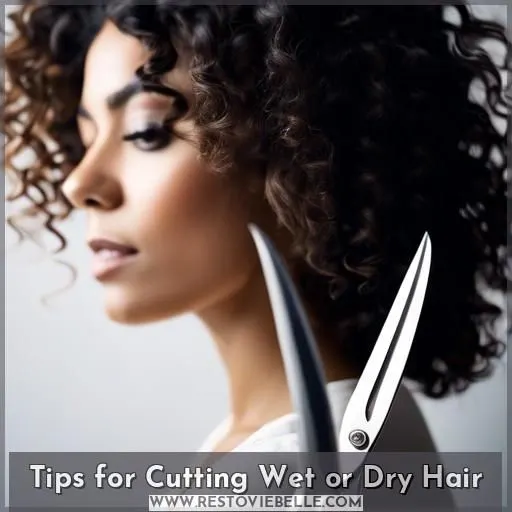This site is supported by our readers. We may earn a commission, at no cost to you, if you purchase through links.

In the realm of curly hair styling, the selection between wet and dry cutting techniques can profoundly influence the aesthetic and well-being of your locks. Dry cutting elevates the inherent beauty of curls, bestowing individualized care upon each strand, and empowering you to effortlessly style your hair. However, it may yield an overly textured appearance.
Wet cutting, conversely, discerns and eliminates split ends, rejuvenates hair health, and is tailored for straightened or heat-styled hair. It can produce a uniform cut when straightened and is favored by those not seeking enhanced volume and definition.
Determining the optimal method hinges upon your hair’s condition and desired style. Seek counsel from a hairstylist specializing in curly hair for expert guidance. Dry cutting is frequently preferred for precision and sharp lines, while wet cutting can contribute to the revitalization of curls.
Employ a few drops of hair oil to enhance manageability and benefit from the advice of a professional hairstylist. The choice between wet and dry cutting can mark a significant difference in the health and appearance of your curly hair.
Table Of Contents
Key Takeaways
- Dry cutting is preferred for precision and strong lines, while wet cutting is ideal for seamless layering and restoring hair health.
- Dry cutting allows for individualized attention to each curl, enhancing their natural appearance and definition, while wet cutting is better for those who straighten or heat-style their hair.
- The choice between wet and dry cutting depends on factors such as hair health, desired style, and the skill set of the stylist.
- A skilled stylist specializing in curly hair can provide personalized recommendations based on your unique curl characteristics and help you achieve the most flattering outcomes for your hair.
Should You Cut Curly Hair Wet or Dry?
The choice between cutting curly hair wet or dry depends on the individual’s hair type and styling goals. Dry cutting, also known as a curly cut or Deva cut, is a method that involves cutting the hair curl by curl while it’s dry, allowing for more precise attention to each curl and better visibility of the final result. This method is particularly beneficial for those with curly, wavy, or coily hair, as it accounts for the varying curl textures across the head and can help enhance the natural curls.
On the other hand, wet cutting is a method that allows a hairstylist to identify and remove split ends, which can help restore hair health. It’s often preferred by those who straighten or heat-style their hair frequently, as the cut may look uneven when straightened out. However, wet cutting may not be the best choice for those with damaged hair, as it may not focus on the overall shape as much as a dry cut.
In summary, cutting curly hair wet or dry depends on the individual’s hair type and styling goals. Dry cutting is generally preferred for those with curly, wavy, or coily hair, as it allows for more precise attention to each curl and better visibility of the final result. Wet cutting is preferred for those who straighten or heat-style their hair frequently, as it allows for the removal of split ends and can help restore hair health.
Dry Cutting Benefits
When cutting curly hair, dry cutting can enhance the natural appearance of your curls, providing personalized attention to each curl and ensuring special care for each one. It empowers customers to style their hair independently, allowing them to see the immediate result of their cut.
Enhances Natural Appearance of Curls
Dry cutting enhances the natural appearance of curls by revealing their true texture and definition. Here’s how:
- Curly Hair Definition: Dry cutting allows for accurate estimation of curl patterns, preserving their unique shape.
- Frizz Reduction: By cutting curls while dry, you can minimize frizz and maintain a smoother finish.
- Texture Enhancement: Dry cutting ensures each curl receives personalized attention, enhancing its natural texture and volume.
- Volume Control: Dry cutting enables stylists to assess the spring factor of each curl, maintaining the desired level of volume.
- Individualized Approach: Dry cutting caters to the specific curl type, ensuring a personalized curly hair cut that meets the individual’s hair needs.
Provides Personalized Attention to Each Curl
Opting for a dry cut technique isn’t just snipping away; it’s a craft that honors your unique curl pattern preservation. It’s like having a curly hair expert tailor your locks, ensuring each curl’s definition shines. This personalized hair styling approach empowers you in mastering home hair care for your desired style.
Ensures Special Care for Each Curl
Dry cutting warrants special attention to each curl, boosting curl retention and texture refinement. It facilitates personalized styling, enhancing controllability and minimizing frizz. Dry cutting serves as a home-based solution for damaged hair, split ends, and excessively textured appearances, while also imparting a customized touch to your haircut.
Empowers Customers to Style Their Hair Independently
Dry cutting empowers customers to style their hair independently. With dry hair trims, you can preserve curl patterns and estimate spring factor accurately. DIY hair care is made easier with a well-lit area and sharp scissors. Zoom-guided haircuts offer at-home cutting options. Healthy hair, curl definition, and manageability are all enhanced with dry cutting.
Wet Cutting Benefits
When contemplating wet cutting for curly hair, you’ll discover its proficiency in disclosing and excising split ends, paramount for preserving hair vitality. It’s likewise the preferred technique for those who often straighten or style with heat, as it can guarantee a consistent length when hair is smooth.
Detects and Removes Split Ends
Regarding curly hair cutting, two primary approaches exist: wet cutting and dry cutting. Each technique offers unique advantages and caters to specific hair types. Let’s examine the benefits of wet cutting, which excels in detecting and eliminating split ends.
Wet cutting is vital for maintaining healthy curls. When hair is wet, it clusters together, facilitating the identification of split ends and other damage. By cutting wet hair, you can remove these damaged ends, preventing them from ascending the hair shaft and causing further harm.
Dry hair may also cluster together, making it challenging to assess thickness and elasticity. Wet cutting allows for a more accurate evaluation of these factors, ensuring a more precise cut.
Knotted curls indicate the need for a trim. Wet cutting assists in identifying these knots, facilitating timely trimming to prevent further damage.
Wet cutting is essential for maintaining healthy curls. Regular trims every 6-8 weeks can prevent split ends and enhance the appearance of your hair.
- Utilize sharp hair scissors in a well-illuminated area.
- Cut dry hair 2-3 days after washing for natural curl definition.
- Shake your head and allow your hair to fall into its natural position before cutting.
- Trim cautiously to avoid excessive hair removal.
Restores Hair Health
Restoring hair health is a key aspect of maintaining curly hair. Wet cutting benefits include the detection and removal of split ends, which can lead to hair damage and hinder growth. By using wet cutting, you can ensure that your hair is healthy and ready for styling.
Consider incorporating curly hair products like Fekkai CBD Calming Supreme Oil, curl cream, and a hydrating conditioner into your curly hair routine to further enhance hair health and prevent frizz.
Suitable for Straightened or Heat-styled Hair
Wet hair trims are your secret weapon if you’re juggling straightened or heat-styled hair. They respect your curl patterns while ensuring each strand’s spring factor and curl definition aren’t lost in translation. It’s like having a zoom-guided haircut, ensuring your curly hair’s volume and density are perfectly balanced, without turning your head into a clump fest.
May Produce an Even Cut When Straightened
Wet cutting can produce an even cut when straightened, making it suitable for those who prefer a smoother look. This technique is beneficial for those with curly hair who straighten or heat-style their hair regularly. By cutting the hair while wet, you can guarantee a more uniform appearance when the hair is dry. This is particularly important for those who want to maintain a straight or sleek style.
Preferred for Those Not Seeking Additional Volume and Definition
Preferred for Those Not Seeking Additional Volume and Definition (Wet Cutting Benefits)
If you’re looking for a haircut that doesn’t emphasize additional volume and definition, wet cutting might be the better option for you. Wet cutting is preferred by those who straighten or heat-style their hair, as it allows the hair to be in its true form, making it easier for the stylist to judge the shape better. This method is suitable for those who want a more natural, subtle look, as wet cutting can distort the shape in the finished style when the hair is stretched and bent.
When cutting curly hair wet, the hair is stretched and bent, which can distort the shape in the finished style. However, a well-versed haircutter will know how to avoid this undesirable result and utilize wet cutting to its full potential. Wet cutting is also beneficial for those with fine or thin hair, as it can achieve the general baseline of a desired hairstyle, and then dry cutting can be used to customize the individual curl patterns and add the desired volume or texture.
Choosing the Best Method
Selecting the appropriate method for trimming your curly locks, whether dry or damp, can notably influence their texture and vitality. It’s vital to seek guidance from a stylist specializing in curly hair to guarantee that your trim complements your natural ringlets and aligns with your style aspirations.
Dry Cut May Result in an Overly Texturized Appearance
Dry cutting can result in an excessively textured appearance, which may not be suitable for all. Over-texturing can lead to excessive volume, curl pattern distortion, and potentially harm hair health. It’s imperative to weigh your hair’s health and desired style before selecting a cutting method.
If you have concerns about texturization or favor a more natural look, wet cutting might be a more appropriate option. Always seek advice from a hairstylist specializing in curly hair to guarantee the best possible results.
Consider Hair Health and Desired Style
When deciding between a wet or dry haircut, it’s vital to think about your hair’s health and desired style. Wet cutting can be advantageous for those with thicker hair, as it allows for easier separation and makes the hair more manageable during the cutting process. On the other hand, dry cutting can be more appropriate for those with curly hair, as it allows for a better grasp of the hair’s natural movement and texture, which is essential for shaping curls and enhancing their definition.
For those with straight hair, both wet and dry cutting methods can be used, depending on the desired outcome. Wet cutting can provide cleaner separation and more precision, while dry cutting can offer accuracy and strong lines, which are ideal for correcting and refining shapes.
It’s also essential to think about the condition of your hair and the skill level of the stylist. If you have curly hair that has lost definition, wet cutting could help bring your curls back to life. Conversely, if you’re aiming for a more transformative, corrective cut, dry cutting may be the better choice.
Ultimately, the best method for you’ll depend on your hair type, texture, thickness, and porosity, as well as your desired style and the skill of the stylist. It’s always a good idea to consult with a hairstylist who specializes in curly hair to determine the best approach for your individual needs.
Seek Advice From a Hairstylist Specializing in Curly Hair
Essential Considerations for Cutting Curly Hair
Seeking professional guidance from a hairstylist with curly hair specialization is imperative. Here are three compelling reasons:
- Comprehensive Hair Care: A hairstylist versed in curly hair can facilitate the maintenance of its well-being. They can impart valuable knowledge on optimal practices tailored to your hair type, including appropriate trimming frequency, cutting techniques, and product recommendations.
- Personalized Recommendations: Every curl pattern is distinctive, and a specialized hairstylist can provide individualized advice based on your unique curl characteristics. Whether you desire a natural or styled appearance, they can guide you towards achieving the most flattering outcomes for your hair.
- Remote Haircuts: If you contemplate a DIY haircut, a hairstylist can provide invaluable assistance. They can elucidate the process, including the utilization of Zoom haircuts for home cuts. Moreover, they can offer advice on post-cut finishing touches and ongoing hair care.
Getting the Most From a Dry Haircut
To maximize the benefits of a dry haircut, seek guidance from a hairstylist skilled in working with curly hair. If attempting a home haircut, opt for a Zoom-guided session to enhance precision. Post-cutting, make any necessary tweaks to optimize the appearance of your curls.
Consult a Hairstylist Specializing in Curly Hair
When tackling those rebellious curls, don’t wing it; seek a stylist’s expertise. They’re the maestros of texture analysis, distinguishing curls from waves, and can tailor a cut that harmonizes with your hair’s unique porosity.
They’ll also fine-tune your scalp care routine, ensuring your locks stay as lush as a tropical rainforest. Trust their savvy scissors for a cut that turns heads and drops jaws.
Consider a Zoom-guided Haircut for At-home Cuts
Consider a Zoom-guided haircut for at-home cuts to enjoy the benefits of both dry and wet cutting methods. This approach offers convenience, affordability, and time-saving advantages.
By using Zoom, you can get a professional haircut from the comfort of your own home without the need for a physical visit to the salon. This method allows you to maintain your hair’s natural appearance while guaranteeing a consistent cut across different textures and styles.
With a Zoom-guided haircut, you can also receive personal attention from a skilled stylist, who can guide you through the cutting process step by step. This guarantees that you achieve the desired look and feel for your hair.
Additionally, the Zoom-guided haircut can be customized to your specific hair type, texture, and desired style, making it a versatile option for those seeking a personalized haircut.
Make Necessary Adjustments at the End
Once you’ve snipped and shaped with precision, it’s time for the grand finale. Think of it as the cherry on top of your curly masterpiece. With the right technique, timing, and tools, those final adjustments transform good into great. It’s not just about cutting; it’s about styling your curls to perfection.
So, wield your scissors like an artist’s brush and make those curls pop!
Tips for Cutting Wet or Dry Hair
When cutting curly hair, the choice between wet and dry cutting depends on various factors such as hair health, desired style, and the skill set of the stylist. Dry cutting is suitable for precision and strong lines, while wet cutting is ideal for seamless layering and restoring hair health. For those with curly hair that has lost definition, wet cutting can help revive curls. However, dry cutting is often preferred for more transformative, corrective cuts, and for straight or heat-styled hair. Ultimately, the best method depends on individual hair goals and the expertise of the stylist.
Use a Few Drops of Hair Oil for Manageability
When cutting curly hair, whether wet or dry, using a few drops of hair oil can greatly improve manageability. Hair oil helps to control flyaways and provides a smooth, silky finish.
For dry cutting, apply the oil before the session to make sure the hair is well-coated and easy to handle.
For wet cutting, apply the oil after the cut to smooth down any frizz or static.
This simple addition can make a significant difference in the overall look and feel of your curly hair.
Seek Guidance From a Professional Hairstylist
Finding a Skilled Stylist for Curly Hair
Paramount when it comes to cutting curly hair is securing a accomplished stylist. While imperative to grasp your hair’s unique attributes, it’s equally imperative to collaborate with a stylist adept in curly hair. Here are recommendations on how to seek guidance from a professional hairstylist:
- Inform Yourself: Prior to scheduling an appointment, investigate the salon’s product offerings and the stylist’s expertise with curly hair. Seek a salon that provides a spectrum of products for various curl types and incorporates natural, sulfate, and paraben-free ingredients. Examine the stylist’s online presence, such as their Instagram portfolio, to ascertain if they’ve a reputation for working with curly hair.
- Solicit Recommendations: Don’t hesitate to request stylists’ opinions on how to tend to your hair. They may propose specific products or techniques that can preserve your curls between visits.
- Consider Cost and Availability: While it’s important to find a stylist who specializes in curly hair, bear in mind that the most adept stylists may be slightly more expensive. Be prepared to pay a premium for their expertise. Also, consider their availability and guarantee they’ve time for your appointment.
- Communicate Clearly: When you arrive at the salon, share your curly hair inspiration photos with your stylist. Confirm that they understand your desired look and any concerns you have about your curls.
- Consult a Specialist: If you’re uncertain about a stylist’s experience with your hair type, request recommendations from their network or reach out to other curly hair specialists in your area.
Frequently Asked Questions (FAQs)
How often should I trim my curly hair?
Trim your curly hair every 6 to 12 weeks, depending on your hair’s specific needs and the severity of split ends.
Can I cut curly hair while it’s dry?
Yes, you can cut curly hair while it’s dry. Dry cutting is beneficial for curly hair because it allows the stylist to work with the hair in its natural state, enhancing the curls and reducing bulk. Dry cutting also enables the stylist to be more precise, as they can see how the hair moves in its natural state and can be selective about which curls they cut and how they’ll fall. This can help prevent an uneven curl pattern and guarantee that each curl is given special attention, leading to a more natural and defined look.
How can I find a skilled stylist for curly hair?
To find a skilled stylist for curly hair, start by inquiring about their education in curly hair techniques. Examine their product inventory to confirm they stock products designed for your hair type. Budget isn’t necessarily the best measure of quality, so be receptive to exploring different price ranges. Inquire about their preferred method and engage them in conversation to assess their expertise.
Investigate their online presence, customer testimonials, and social media connections to evaluate their professionalism. Bear in mind that the ideal stylist for your curls may not be the one you’re familiar with or the most costly, but someone who genuinely comprehends your unique curl characteristics.
What products should I use for curly hair?
To achieve the best results for your curly hair, consider using a combination of both wet and dry cutting techniques. Wet cutting can help remove weight, affecting the spring and coil of your curls, and rough in the general shape for better flow. It also gives consistent curl ends, reducing frizz and making it easier to account for textural differences. On the other hand, dry cutting can provide immediate visibility of the final result, consider variations in curl textures, and give personalized attention to each curl, enhancing the natural appearance of curls** and ensuring special care for each curl.
For ideal results, utilize both wet and dry cutting techniques. This approach allows you to address different hair needs and styles, and it differs from branded haircuts that emphasize only one approach. Customers appreciate the ease and consistency of their hair when both methods are used.
How can I maintain healthy curls?
To maintain healthy curls, focus on using the right products designed for curly hair. Look for sulfate-free shampoos and conditioners that provide hydration and nourishment without weighing down the curls. Avoid drying ingredients like sulfates and opt for moisturizing ingredients that enhance curl definition and reduce frizz.
Use a microfiber towel or a soft cotton T-shirt to gently absorb water from your hair, and avoid traditional towels that can cause frizz. Allow your hair to air-dry naturally or use a diffuser attachment in a low heat setting to minimize frizz.
Regular conditioning is essential for curly hair, so opt for products specifically formulated for dry or curly hair. Incorporate curl-specific products that enhance your natural curl pattern and provide hydration and nourishment.
Additionally, consider using natural oils like coconut or olive oil to improve blood circulation and promote healthy hair growth.
Conclusion
According to the article, dry cutting is often preferred for curly hair due to its ability to enhance the natural appearance of curls and provide personalized attention to each curl. On the other hand, wet cutting is beneficial for detecting and removing split ends and restoring hair health.
The best method for you depends on your hair’s condition and desired style. Always consult with a hairstylist specializing in curly hair to guarantee the best results.











